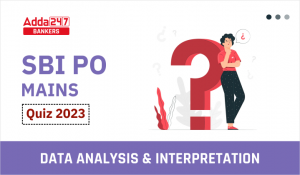(a) making loans or advances
(b) drawing or accepting bills payable otherwise than on demand
(c) allowing interest on deposits or current accounts
(d) All of the above
(e) None of the given options is true
S1. Ans.(d)
Sol. i. make loans or advances;
ii. draw or accept bills payable otherwise than on demand;
iii. allow interest on deposits or current accounts.
Q2. Section 31 (2) of the Reserve Bank of India Act, 1934 prohibits of making or issuing of a expressed to be payable to bearer thereof
(a) cheque
(b) bill of exchange
(c) promissory note
(d) demand draft
(e) None of the given options is true
S2. Ans.(c)
Sol. Section 31 (2) of the Reserve Bank of India Act, 1934- Notwithstanding anything contained in the Negotiable Instrument Act, 1881 (26 of 1881), no person in India other than the Bank or, as expressly authorised by this Act, the Central Government shall make or issue any promissory note expressed to be payable to the bearer of the instrument.
Q3. Drawing, accepting, making or issuing of any promissory note, hundi or bill of exchange expressed to be payable to bearer on demand by a person other than the Reserve Bank of India or the Central Government is prohibited under-
(a) Banking Regulation Act, 1949
(b) Section 31 (1) of the Reserve Bank of India Act, 1934
(c) Negotiable Instruments Act, 1881
(d) Indian Contract Act, 1872
(e) None of the given options is true
S3. Ans.(b)
Sol. Section 31. Issue of demand bills and notes-
Under Section 31 (1) No person in India other than the Bank, or, as expressly authorised by this Act the Central Government shall draw, accept, make or issue any bill of exchange, hundi, promissory note or engagement for the payment of money payable to bearer on demand, or borrow, owe or take up any sum or sums of money on the bills, hundis or notes payable to bearer on demand of any such person:
PROVIDED that cheques or drafts, including hundis, payable to bearer on demand or otherwise may be drawn on a person’s account with a banker, shroff or agent.
Q4. Rupee coins are the legal tender in India under the provisions of-
(a) Reserve Bank of India Act, 1934
(b) Negotiable Instruments Act, 1881
(c) Banking Regulation Act, 1949
(d) Indian Coinage Act, 1906
(e) None of the given options is true
S4. Ans.(d)
Sol. The 1906 Coinage Act, is an Act to govern the laws related to Coinage and Mints in India.
Q5. In India, the system of decimal coinage was introduced on-
(a) 15th August 1947
(b) 26th January 1950
(c) 1st April 1957
(d) All of the above
(e) None of the given options is true
S5. Ans.(c)
Sol. The move towards decimalization was afoot for over a century. However, it was in September 1955 that the Indian Coinage Act was amended for the country to adopt a metric system for coinage. The Act came into force with effect from 1stApril, 1957. The rupee remained unchanged in value and nomenclature. It, however, was now divided into 100 ‘Paisa’ instead of 16 Annas or 64 Pice. For public recognition, the new decimal Paisa was termed ‘Naya Paisa’ till 1stJune, 1964 when the term ‘Naya’ was dropped.
Q6. Sub-section 12AB of Section 17 of the Reserve Bank of India Act, 1934 defines the term as an instrument for borrowing funds by selling securities of the Central Government or a State Government or of such securities of a local authority as may be specified in this behalf by the Central Government or foreign securities, with an agreement to repurchase the said securities on a mutually agreed future date at an agreed price which includes interest for the funds borrowed?
(a) Bank rate
(b) LAF
(c) Repo
(d) CRR
(e) None of the given options is true
S6. Ans.(c)
Sol. Sub-section (12AB) of section 17 of the RBI Act, 1934, defines-
“repo” as “an instrument for borrowing funds by selling securities of the Central Government or a State Government or of such securities of a local authority as may be specified in this behalf by the Central Government or foreign securities, with an agreement to repurchase the said securities on a mutually agreed future date at an agreed price which includes interest for the funds borrowed”.
“reverse repo” means an instrument for lending funds by purchasing securities of the Central Government or a State Government or of such securities of a local authority as may be specified in this behalf by the Central Government or foreign securities, with an agreement to resell the said securities on a mutually agreed future date at an agreed price which includes interest for the funds lent.”
Q7. In terms of Section 24 of the Reserve Bank of India Act, 1934, the Reserve Bank of India may issue bank notes for the maximum denomination of-
(a) Rs. 500
(b) Rs. 5000
(c) Rs. 10000
(d) Rs. 1000
(e) Rs. 10
S7. Ans.(c)
Sol. In terms of Section 24 of the Reserve Bank of India Act, 1934, the Reserve Bank of India may issue bank notes for the maximum denomination of Rs. 10,000.
Q8. The term ‘moral suasion’ refers to-
(a) the moral duty of a borrower to deal with only one bank
(b) the banker’s duty of secrecy as regards the affairs and accounts of his customers
(c) the advice was given by Reserve Bank to banks/financial institutions in the matter of their lending land other operations with the objective that they might implement or follow it
(d) All of the above
(e) None of the given options is true
S8. Ans.(c)
Sol. the advice was given by Reserve Bank to banks/financial institutions in the matter of their lending land other operations with the objective that they might implement or follow it.
Q9. Which of the following is the sale authority for issue of currency in India?
(a) Government of India
(b) Reserve Bank of India
(c) Controller of Currency
(d) All of the above
(e) SEBI
S9. Ans.(b)
Sol. RBI is the sale authority for issue of currency in India.
Q10. The minting of rupee coin is governed by-
(a) Coinage Act, 1906
(b) Reserve Bank of India Act, 1934
(c) Banking Regulation Act, 1949
(d) Currency Act, 1902
(e) None of the given options is true
S10. Ans.(a)
Sol. The minting of rupee coin is governed by Coinage Act, 1906.
Q11. One rupee notes and coins are issued by-
(a) Reserve Bank of India
(b) State Bank of India on behalf of Government of India
(c) Ministry of Finance
(d) Finance Minister of Central Government
(e) None of the given options is true
S11. Ans.(c)
Sol. The One Rupee note is issued by Ministry of Finance and it bears the signatures of Finance Secretary, while other notes bear the signature of Governor RBI.
Q12. Bank rate policy, open market operations, variable reserve requirements and statutory liquidity requirements employed by Reserve Bank as measures of credit control are classified as-
(a) quantitative methods
(b) qualitative methods
(c) RBI methods
(d) All of the above
(e) None of the given options is true
S12. Ans.(a)
Sol. Quantitative Measures or methods- Bank Rate Policy. Open Market Operations. Cash Reserve Ratio. Statutory Liquidity Ratio.
Q13. Which of the following instruments of credit control adopted by Reserve Bank of India does not fall within ‘general’ or ‘quantitative’ methods of credit control?
(a) Stipulation of certain minimum margin in respect of advance against specified commodities
(b) Open market operations
(c) Bank rate
(d) Variable reserve requirements
(e) None of the given options is true
S13. Ans.(a)
Sol. Stipulation of certain minimum margin in respect of advance against specified commodities.
Q14. The opening of branches by banks is governed by the provisions of-
(a) Section 23 of the Banking Regulation Act, 1949
(b) Section 24 of Reserve Bank of India Act, 1934
(c) Section 131 of the Negotiable Instruments Act, 1881
(d) Section 45 and Bank Nationalisation Act, 1969
(e) None of the given options is true
S14. Ans.(a)
Sol. The opening of new branches and shifting of existing branches of banks is governed by the provisions of Section 23 of the Banking Regulation Act, 1949. In terms of these provisions, banks cannot, without the prior approval of the Reserve Bank of India (RBI), open a new place of business in India or abroad or change, otherwise than within the same city, town or village, the location of the existing place of business. Section 23 (2) of the Banking Regulation Act lays down that before granting any permission under this section, the Reserve Bank may require to be satisfied, by an inspection under Section 35 or otherwise, as to the financial condition and history of the banking company, the general character of its management, the adequacy of its capital structure and earning prospects and that public interest will be served by the opening or, as the case may be, change of location of the existing place of business. RRBs should approach the concerned Regional Offices of RBI in this regard.
Q15. Which of the following fall under the qualitative methods of credit control adopted by Reserve Bank of India?
(a) Selective Credit Control
(b) Credit Authorisation Scheme
(c) Moral Suasion
(d) All of the above
(e) None of the given options is true
S15. Ans.(d)
Sol. All of the above fall under the qualitative methods of credit control adopted by Reserve Bank of India.









 Quantitative Aptitude Quiz For SBI PO Ma...
Quantitative Aptitude Quiz For SBI PO Ma...
 Inequalities Basic Reasoning Quiz for Al...
Inequalities Basic Reasoning Quiz for Al...







